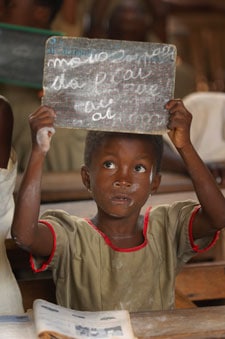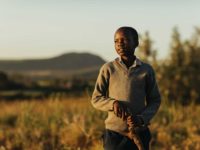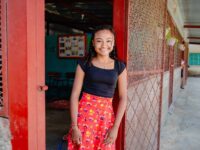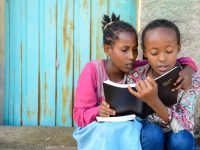Our holistic child development model is central to our mission of releasing children from poverty in Jesus’ name. And the curriculum standards we have put in place in all of our programs are key to achieving this goal.
 In recent years, we developed a global curriculum to help develop children holistically — physically, spiritually, cognitively and socio-emotionally. It is designed to be nonacademic, similar to an after-school enrichment program. For example, instead of learning math, children learn how to apply mathematical skills.
In recent years, we developed a global curriculum to help develop children holistically — physically, spiritually, cognitively and socio-emotionally. It is designed to be nonacademic, similar to an after-school enrichment program. For example, instead of learning math, children learn how to apply mathematical skills.
Another example is that in many of the countries where we work, children are taught to stay quiet and to not share their opinions. Instead of just telling them what to do, we work through our curriculum to empower children to have their own voice when they leave our sponsorship program.
“We want them to own their own development,” says Mary Ann Springer, who led the curriculum design. “As an example, we train the children how to eat well so they can make good decisions on their own.”
The new curriculum is both age-appropriate and contextualized to fit the needs of the children. For example, in our Child Sponsorship Program the lesson plans are aimed at age groups of: 3-5, 6-8, 9-11, 12-14, 15-18 and 19 and above.
For the 3- to 5-year-olds, a physical lesson might be learning about basic hygiene, such as brushing your teeth. The spiritual lesson might be learning a Bible story. A socio-emotional lesson might include learning how to treat others. A cognitive lesson might teach about the five different senses.
Global curriculum standards ensure quality programming in our child development centers by giving the tutors easy-to-use and effective material to teach the children. Another important benefit is having measurable “outcomes” and “indicators.”
“Every lesson plan and activity points to a specific outcome and indicator,” says Springer. “The goal is for every student to graduate having achieved the four outcomes, each with three indicators, for the lesson plan.”
For example, one outcome of physical development is that a child “chooses good health practices and is physically healthy.” The three indicators associated with this outcome are that the child:
- demonstrates an appropriate understanding of his or her physical body
- experiences reduced incidence of illness, nutritional deficiencies and physical impediments
- takes responsibility for wise life choices about health and sexuality
The new curriculum standards also provide for focused, detailed lesson plans. This allows the tutors to have a clear path to obtain the desired objectives. It greatly helps the teachers prepare the classroom programs. With less time devoted to preparing lesson plans and with better tools, they are able to give individualized attention to each child.
The curriculum uses various methods of teaching in order to reach every child’s learning style, whether that’s hands-on, auditory or visual. Most of the lessons are participatory, including small groups, discovery and games.
Because we work in so many diverse cultures, each of our country offices has the freedom to contextualize the curriculum to their specific needs. For example, in Indonesia, one of the lessons had been designed to teach the children how to tie their shoes. However, in some of the communities in Indonesia, they wear sandals, not shoes that tie. Contextualizing helps our offices weed out culturally irrelevant content.
The variations of the curriculum range widely from country to country. Some use the standards as they are and some have made major changes. For example, in Rwanda, due to the past internal conflicts, there is an emphasis on teaching forgiveness.
“As long as there is balance within the curriculum, the countries have freedom to adjust the curriculum to their needs,” says Springer.
Our new curriculum helps children develop into whom God made them to be, and the tutors no longer feel burdened with developing daily lesson plans. They now have the time to devote to the children to encourage them to grow holistically.
As the new curriculum standards are implemented in more child development centers, we draw one step closer to using fully realizing our mission: releasing children from poverty in Jesus’ name.







15 Comments |Add a comment
How much of a gift is needed to buy your child a goat?
Thank you for your question, Denise! I have included a link below to the gift catalog on our website with more information about giving the gift of a goat to a family! If you have any additional questions please send us an email at [email protected] and we will be happy to help.
https://www.compassion.com/catalog/donate-a-goat-charity-gift.htm
Thankyou so much for good work you’re doing I’m so glad the children are taught well.
I am so thankful for Compassion International. We, in the U.S., are so very blessed to have abundant food, clothing and homes. I consistently pray for little Alexix in Rwanda and his family that they will know and love Jesus more and more. The curriculum that is used sounds so Biblical and practical.
Great job in ensuring that you have a wholistic curriculum in place to release children from poverty.
How can I get a copy to get some idea on how the curriculum contain?
Thanks
Violet
I came across compassion and the work you guys are doing is mind blowing. I come from a country (nigeria) with plenty wealth and poverty and have worked with both.
Wonderful development model description too. Where can i get a full copy? Can we adopt it?
Good work. GOD continually strengthen you all. In JESUS Name
helo im isaack noah age of 21 male living dar es salaam east africa tanzania i looking the post of teaching children any where and to take care of them to know the love of jesuss and hw jesus is good for us thnx
kind regards isaack noah
Hi, Isaac, I’m not sure that I totally understand the question. Are you saying that you would like to find a church where you could learn more about this? Or are you saying that you would like to register a child into a Compassion student center in Tanzania? In that case, you probably want to get a hold of the country office in Tanzania and see if they know of a student center close to where you or the child lives. If you want to know more about Jesus and His Love, I would suggest that you’d read the Gospel of John. It is specifically written for that express type of purpose. You are welcome to check out my testimony at: http://www.integrity-websites.com/icabout.htm but I will say that it was written with Americans in mind. So, just read the last half. The first half is about a Western movie character.
This is really good. I am amazed at what I’ve seen these children being taught in the student centers. They truly cover the whole gamut. They truly get a total education, covering every area.
Thank you for sharing this. It’s awesome to hear about the standards and indicators for the new curriculum. 🙂
Thank you for this post. How can I find out more information about the new curriculum please? I would really like to view a copy of it- is there some way that I can do that please? thank you
Amy,
I’ll put you in touch withy Mary Ann Springer.
Hi – I know this is a late comment to this post, but we are working to develop a children’s curriculum for a Christian Day center out church has developed in Zambia. Is there a way to view your curriculum? Thank you!! And thank you for all that Compassion does around the world. We love our program 🙂
Hi Rachel! I can get you an abbreviated copy of our curriculum and will e-mail you directly so we can coordinate the best way to get it to you. Jacquie
This is great! Well done to all who have planned it and implemented it!